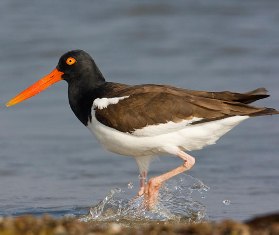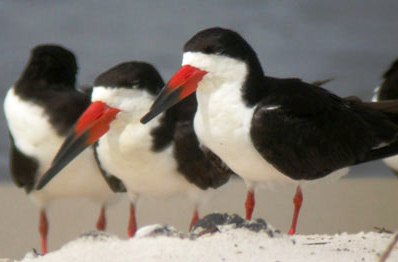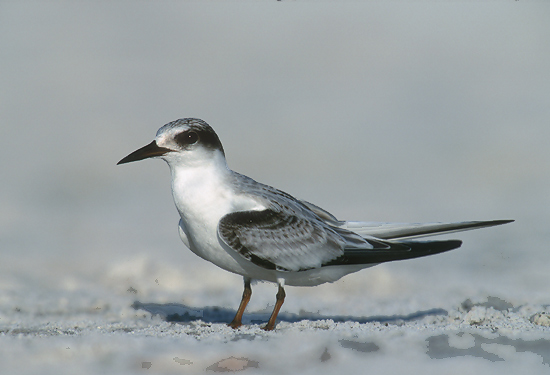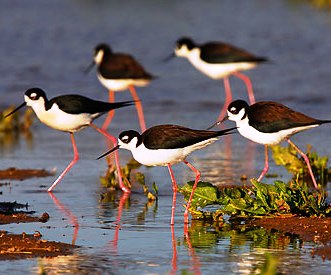Discover Florida Nature
It's time to explore the natural Florida


|
|
|
|
|
 American
Oystercatcher
- Since it is one of the largest and heaviest of our shorebirds, the
oystercatcher is unmistakable. It is striking in appearance: dark-brown,
black, and white, with a bright red bill. When in flight, a diagonal
white stripe in each wing forms a V-pattern. Oystercatchers get their
name from their habit of snatching oysters from slightly open shells.
They also use their powerful bills to open mollusks and to sort through
heavy shells in search of food. The oystercatcher needs extensive
sandbars and mudflats for feeding and sand or shell-covered beaches free
from predators and human disturbance for nesting. The birds usually nest
in shallow depressions scraped out of sand, in areas surrounded by
water, since they are very sensitive to disturbance and susceptible to
mammalian predators. Unfortunately the availability of safe nesting
places is declining. Florida Oystercatchers are best spotted in
Apalachicola Bay, Tampa Bay, and the
Cedar Keys. American
Oystercatcher
- Since it is one of the largest and heaviest of our shorebirds, the
oystercatcher is unmistakable. It is striking in appearance: dark-brown,
black, and white, with a bright red bill. When in flight, a diagonal
white stripe in each wing forms a V-pattern. Oystercatchers get their
name from their habit of snatching oysters from slightly open shells.
They also use their powerful bills to open mollusks and to sort through
heavy shells in search of food. The oystercatcher needs extensive
sandbars and mudflats for feeding and sand or shell-covered beaches free
from predators and human disturbance for nesting. The birds usually nest
in shallow depressions scraped out of sand, in areas surrounded by
water, since they are very sensitive to disturbance and susceptible to
mammalian predators. Unfortunately the availability of safe nesting
places is declining. Florida Oystercatchers are best spotted in
Apalachicola Bay, Tampa Bay, and the
Cedar Keys.  Black
Skimmer- Black skimmers “skim” the surface of the water with
black-tipped bright red bills. The lower half of the bill is longer than
the upper, allowing it to cut through the water and dip down to grab
small fish encountered near the surface. Adult plumage is black above,
white below and this striking combination, coupled with the brightly
colored bill, makes it easy to spot the birds as they hunt over the
water or loaf on the beach with other seabirds and shorebirds. Black
skimmers, and least, royal and sandwich terns nest in colonies in the
open sand on beaches, sandbars, and dredge material islands. Their nests
are built on the ground and often consist of simple scrapes in the sand.
(Due to habitat loss, a very small percentage of black skimmers also
nest on gravel roofs!) Black skimmers rely on camouflage or group
mobbing to protect their nests. Breeding colonies of black skimmers can
be found along Florida’s Gulf and Atlantic coasts. Watch for them in the
early evening when they actively feed, and scan flocks of loafing birds
for this uncommon coastal resident. Black
Skimmer- Black skimmers “skim” the surface of the water with
black-tipped bright red bills. The lower half of the bill is longer than
the upper, allowing it to cut through the water and dip down to grab
small fish encountered near the surface. Adult plumage is black above,
white below and this striking combination, coupled with the brightly
colored bill, makes it easy to spot the birds as they hunt over the
water or loaf on the beach with other seabirds and shorebirds. Black
skimmers, and least, royal and sandwich terns nest in colonies in the
open sand on beaches, sandbars, and dredge material islands. Their nests
are built on the ground and often consist of simple scrapes in the sand.
(Due to habitat loss, a very small percentage of black skimmers also
nest on gravel roofs!) Black skimmers rely on camouflage or group
mobbing to protect their nests. Breeding colonies of black skimmers can
be found along Florida’s Gulf and Atlantic coasts. Watch for them in the
early evening when they actively feed, and scan flocks of loafing birds
for this uncommon coastal resident. Least
Tern-
Like all North American terns, the least tern has long, pointed wings
and a deeply forked tail. It is the smallest of our terns, and bears
outer wing feathers that edge the light-gray wings in black. The
breeding adult is gray above, white below, with a black cap. In early
spring least terns return from wintering grounds in Latin America. They
soon pair up using courtship rituals in which hopeful males offer small
fish to prospective mates. The shorebirds nest in very shallow
depressions on broad expanses of bare sand, which camouflage the eggs.
They lay from mid-April in south Florida to the first of May in the
north, and the eggs hatch after 21 days. The young leave the nest in a
few days, but don't begin to fly safely until about three weeks later.
Populations of least terns sank after the turn of the century, when they
were hunted to harvest their feathers to decorate women's hats. Not only
are the birds extremely susceptible to nest disturbance, they have lost
extensive nesting habitat to beach development and increased human
activity there. Least terns are colony nesters, meaning they nest in a
group, which allows them to exchange information about food sources, as
well as to detect and mob predators. An entire colony can be easily
destroyed by predation by red foxes, raccoons, dogs and house cats, by
human trampling, or by catastrophic storms. Least
Tern-
Like all North American terns, the least tern has long, pointed wings
and a deeply forked tail. It is the smallest of our terns, and bears
outer wing feathers that edge the light-gray wings in black. The
breeding adult is gray above, white below, with a black cap. In early
spring least terns return from wintering grounds in Latin America. They
soon pair up using courtship rituals in which hopeful males offer small
fish to prospective mates. The shorebirds nest in very shallow
depressions on broad expanses of bare sand, which camouflage the eggs.
They lay from mid-April in south Florida to the first of May in the
north, and the eggs hatch after 21 days. The young leave the nest in a
few days, but don't begin to fly safely until about three weeks later.
Populations of least terns sank after the turn of the century, when they
were hunted to harvest their feathers to decorate women's hats. Not only
are the birds extremely susceptible to nest disturbance, they have lost
extensive nesting habitat to beach development and increased human
activity there. Least terns are colony nesters, meaning they nest in a
group, which allows them to exchange information about food sources, as
well as to detect and mob predators. An entire colony can be easily
destroyed by predation by red foxes, raccoons, dogs and house cats, by
human trampling, or by catastrophic storms. Black-Necked
Stilt- With its black and white plumage, long, thin red legs,
and long neck, the Black-necked Stilt is both striking and delicate in
appearance. It is a medium-sized shorebird with a black needle-like
bill, black or dark brown upperparts, and a white breast. The iris is
red, and there is a white spot above the eye. Breeding males have glossy
black wings, back, and back of neck, and a pink tinge on the breast.
Non-breeding males lack the glossiness and pink tinge. Adult females
have a brown tinge to the back. Juveniles have brown upperparts with
buff feather margins, and a white trailing edge to the wing in flight.
Five species of rather similar-looking stilts are recognized in the
genus Himantopus. They have the second-longest legs in proportion to
their bodies of any bird, exceeded only by flamingos. This bird's
habitat includes salt ponds, rice fields, shallow lagoons, and mangrove
swamps. Black-necked Stilts most often consume aquatic invertebrates.
They also sometimes eat tadpoles, tiny fish, and seeds of aquatic
plants. Pairs form on wintering grounds, during migration, or on
breeding grounds; pairs remain monogamous throughout the breeding
season. Both sexes choose the nest site, which is often on a small
island in the marsh. Black-Necked
Stilt- With its black and white plumage, long, thin red legs,
and long neck, the Black-necked Stilt is both striking and delicate in
appearance. It is a medium-sized shorebird with a black needle-like
bill, black or dark brown upperparts, and a white breast. The iris is
red, and there is a white spot above the eye. Breeding males have glossy
black wings, back, and back of neck, and a pink tinge on the breast.
Non-breeding males lack the glossiness and pink tinge. Adult females
have a brown tinge to the back. Juveniles have brown upperparts with
buff feather margins, and a white trailing edge to the wing in flight.
Five species of rather similar-looking stilts are recognized in the
genus Himantopus. They have the second-longest legs in proportion to
their bodies of any bird, exceeded only by flamingos. This bird's
habitat includes salt ponds, rice fields, shallow lagoons, and mangrove
swamps. Black-necked Stilts most often consume aquatic invertebrates.
They also sometimes eat tadpoles, tiny fish, and seeds of aquatic
plants. Pairs form on wintering grounds, during migration, or on
breeding grounds; pairs remain monogamous throughout the breeding
season. Both sexes choose the nest site, which is often on a small
island in the marsh. |
|
|
Advertise | Privacy Statement | Dog Encyclopedia | Video |Contact | Alaska Nature |
|